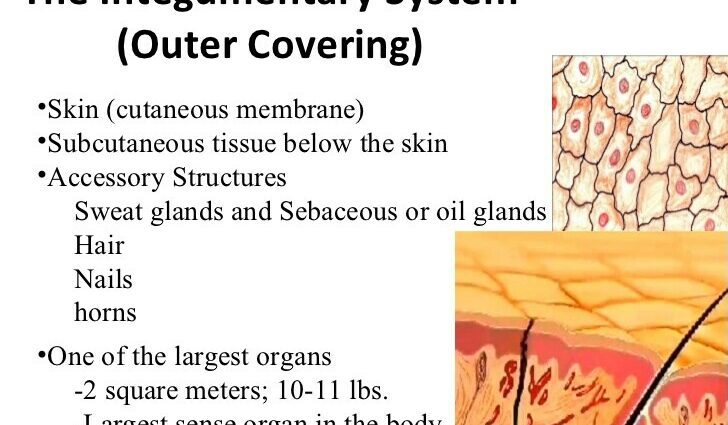Integument: function of the covering tissue of the body
The integuments are the outer covering of the body. In humans, it is the skin and its appendages such as integuments: hair, hair, nails. The main function of the integuments is to protect the organism from attacks from the external environment. Explanations.
What is an integument?
The integuments are the outer covering of the body. They ensure the protection of the body against multiple attacks from the external environment. They are made up of the skin and various structures or skin appendages.
The skin is made up of 3 layers which come from 2 tissues of different embryological origins: the ectoderm and the mesoderm. These 3 skin layers are:
- the epidermis (visible on the surface of the skin);
- the dermis (located under the epidermis);
- hypodermis (deepest layer).
The surface of the integument is very important, starting with that of the skin which is about 2 m2, weighing 4 to 10 kg in adults. The thickness of the skin, 2 mm on average, varies from 1 mm at the level of the eyelids to 4 mm at the level of the palms of the hands and the soles of the feet.
The 3 skin layers
The skin is the main integument. It is made up of 3 layers: the epidermis, the dermis and the hypodermis.
The epidermis, the surface of the skin
The epidermis is located on the surface of the skin. It consists of epithelium and connective cells of ectodermal origin. It is the main protective structure of the body. The epidermis is not vascularized. Certain ancillary structures are associated with it, such as the integuments (nails, hair, hairs, etc.) and the skin glands.
At the base of the epidermis is the basal layer. It is covered with germ cells called keratinocyte (cells that synthesize keratin). Over time, the accumulation of keratin in cells leads to their death. A layer of dead cells called stratum corneum covers the surface of the epidermis. This impermeable layer protects the body and is eliminated by a process of desquamation.
Under the epidermal basal layer are nerve endings associated with nerve cells in the epidermis or Merckel cells.
The epidermis also has melanocytes which synthesize melanin grains allowing UV protection and giving the skin its color.
Above the basal layer is the prickly layer which contains Langerhans cells which perform an immune role. Above the thorny layer is the granular layer (surmounted by the stratum corneum).
The dermis, a support tissue
Le dermis is the supporting tissue of the epidermis. It is made up of connective tissue of mesodermal origin. It appears looser than the epidermis. It contains the receptors for the sense of touch and the skin appendages.
It is a nourishing tissue of the epidermis thanks to its vascularization: endowed with many blood and lymphatic vessels, it ensures the supply of oxygen and nutrients to the structures of the integumentary system and the return of waste (CO2, ureas, etc.) to the purification organs (lungs, kidneys, etc.). It also participates in the development of skeletal formations (by dermal ossification).
The dermis is made up of two types of intertwined fibers: collagen fibers and elastin fibers. Collagen participates in the hydration of the dermis while elastin gives it strength and resistance. These fibers are secreted by fibroblasts.
Nerve endings cross the dermis and join the epidermis. There are also different corpuscles:
- Meissner’s corpuscles (sensitive to touch);
- Ruffini’s corpuscles (sensitive to heat);
- Pacini’s corpuscles (pressure sensitive).
Finally, the dermis has several types of pigment cells (called chromatophores).
The hypodermis, a deep layer
L‘hypoderme is closely related to the skin without really being part of it. It is made up of adipose connective tissue (of mesodermal origin) as it exists in other regions of the body. This tissue is like the dermis looser than the epidermis.
Skin appendages
The skin appendages are located in the dermis.
The pilosebaceous apparatus
This consists of:
- of the hair follicle which makes it possible to manufacture the hair;
- the sebaceous gland which produces sebum;
- the suboriparous apocrine gland which carries olfactory messages;
- of the pilomotor muscle which causes the hair to straighten.
The eccrine sweating apparatus
It produces sweat evacuated by the pores.
The nail apparatus
It produces the nail.
What are the functions of the seed coat?
The integument performs a large number of functions within the body:
- Protection against UV, water and humidity (waterproof layer), trauma, pathogens, etc. ;
- Sensory function : sensory receptors in the skin allow sensitivity to heat, pressure, touch, etc. ;
- Synthesis of vitamin D;
- Excretion of substances and wastes;
- Thermal regulation (by evaporation of sweat in order to regulate the internal temperature, etc.).










